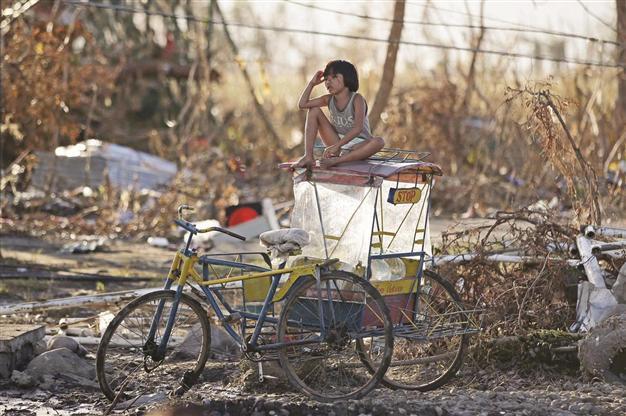Law and order prevailing in Philippine typhoon chaos
TACLOBAN

A Filipino girl rests on top of a pedicab parked in front of toppled trees and poles left from Typhoon Haiyan, Tacloban city, Leyte province, central Philippines on Friday, Nov. 15, 2013. AP Photo
Fears that the dire situation among desperate typhoon survivors in the Philippines would tip into violence receded, as relief operations scaled up and a reinforced police presence deterred looters.
At Tacloban airport, which had witnessed frenzied scenes earlier in the week as crowds fought for a seat on any plane leaving the devastated city, a semblance of order had been restored. “Things are looking very different here than they were when we arrived,” said Cpt. Jon Shamess of the U.S. Airforce’s 320th Special Tactics Squadron, which had flown in from Okinawa on Nov. 12 to help secure the airport. Helping stabilize the situation was the arrival of the U.S. aircraft carrier, USS George Washington, which began flying in urgently needed aid to towns worst-hit by Super Typhoon Haiyan.
“Before, as soon as a plane landed, people were all rushing towards it trying to get on, which is obviously a very dangerous situation,” Shamess said. There were still thousands of people desperate to get out, but most stood patiently, waiting their turn.
In Tacloban city the police deployment had swelled to around 1,200, with reinforcements flown in from Manila, according to Wilben Mayor, spokesman for the Philippines national police chief. “There was some looting but that has been contained now,” Mayor told Agence France-Presse.
“We’re still very alert to the security situation, but our focus is switching from crime prevention to supporting the relief effort,” he added. A strict dusk-to-dawn curfew has been in force in Tacloban since Nov. 11 night. Isolated shooting incidents in the immediate aftermath of last week’s super typhoon had fuelled concerns of a breakdown in law and order as survivors struggled to survive without food, water or electricity. The Philippines raised its official death toll from a super typhoon to 3,621, but it was still below a U.N. count that has caused friction between the world body and the government.
Reynaldo Balido, spokesman for the National Disaster Risk Reduction and Management Council, said the number of confirmed dead had risen significantly from the previous count of 2,360, adding that 1,140 were reported missing. Citing regional authorities, the U.N. said Nov. 15 the latest figure for the number of dead in last week’s storm -- one of the most powerful ever recorded -- was at least 4,460.
